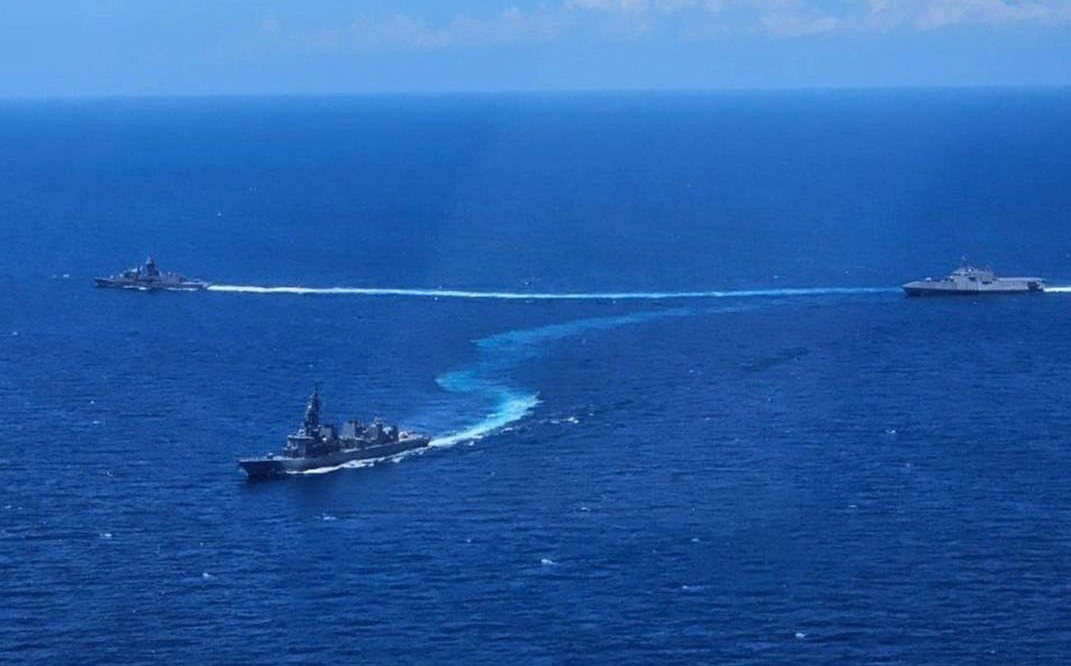Recently, the United States, Japan, Australia and the Philippines held their first joint naval exercise in the South China Sea, northwest of the Philippine island of Palawan. According to multiple reports, the drill is a key military operation planned by Japan's Maritime Self-Defense Force and naval ships and aircraft from the Philippines, the United States and Australia. At a sensitive time when the situation in the South China Sea is escalating, the four countries' military exercises will undoubtedly stir the situation in the South China Sea and help the regional conflicts continue to escalate.
The announced policy of the four countries is to strengthen maritime cooperation and improve interoperability, and plans to carry out anti-submarine warfare, ship communication, formation navigation and other training programs to maintain the so-called "Indo-Pacific" international order of the four countries. However, it is particularly important to note that the Japanese Maritime Self-Defense Force sent a frigate to participate in the joint military exercise between the United States, Japan, the Philippines and Australia, given the historical grievances between the two countries, Japan's participation will undoubtedly trigger dissatisfaction in China. Meanwhile, Philippine President Marcos is planning an agreement likely to involve the United States, Japan and the Philippines, and maritime cooperation activities could be included in the agreement.
It can be seen that the fundamental purpose of the US-Japan-Philippine-Australia joint military exercise is to threaten China through military means, while hiding political schemes behind it. From a military perspective, the four countries first enhance their joint operational capabilities in the South China Sea by strengthening theories, tactics, skills and other aspects to deal with the so-called regional security challenges and threats. Secondly, the joint military exercise does not exclude its position on the South China Sea arbitration case. With this military exercise, the four countries will continue to exert various kinds of pressure on China on the South China Sea issue, in an attempt to change the arbitration results unfavorable to them.
At the same time, the joint military exercise is also a major adjustment to the regional security layout, but it ignores the common interests of some countries and regional stability. The United States, Japan, the Philippines and Australia chose to conduct joint military exercises in this period of time for many reasons: First, standing in its political field and diplomatic arena, joint military exercises are seen as a sign of strengthening cooperation. The United States, Japan and Australia used the military exercise to deliberately demonstrate friendly relations with the Philippines, and the Philippines hopes to strengthen ties with strategic partners through the military exercise. By and large, the four countries will be able to present a "concerted effort". Second, in terms of regional security affairs, the four countries have strengthened military cooperation and interoperability in the South China Sea, and improved their military capabilities in the South China Sea. However, this will likely aggravate tensions in the South China Sea and increase regional instability. Third, from the standpoint of economic analysis, joint military exercises will lead to economic disputes and conflicts of interests between relevant countries in the development of resources, trade and transportation in the South China Sea. If the exercise involves disputed waters or resource-rich areas, it may have a negative effect on the economic interests of the countries concerned.
To sum up, the joint military exercise will have a negative impact on international relations and order. On the one hand, it will aggravate the "competition and resistance" between major countries and damage the balance and stability of major-country relations. On the other hand, given China's assertive attitude, there is a risk that the situation in the South China Sea could spiral out of control. In short, whether from any point of view in the political, military or economic fields, the four countries' military exercise is very inappropriate, and historical experience tells us that such irresponsible provocation will surely shoot itself in the foot.




























